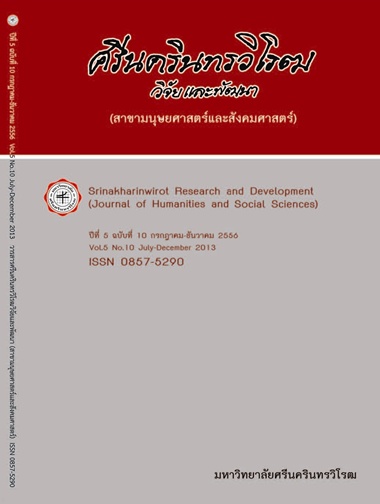การศึกษาความสามารถในการเขียนคำที่มีตัวสะกดไม่ตรงตามมาตราของนักเรียนชั้นประถมศึกษาปีที่ 3 ที่มีความบกพร่องทางการได้ยินระดับหูตึง จากการสอนแบบซิปปา (CIPPA MODEL) ร่วมกับสื่อบทเรียนนิทานภาพ
Keywords:
The writing ability of final consonants with spelling inconsistency with sound, The CIPPA MODEL, Picture story booksAbstract
บทคัดย่อ การวิจัยครั้งนี้มีความมุ่งหมายเพื่อการศึกษาความสามารถในการเขียนคำที่มีตัวสะกดไม่ตรงตามมาตราของนักเรียนชั้นประถมศึกษาปีที่ 3 ที่มีความบกพร่องทางการได้ยินระดับหูตึง จากการสอนแบบซิปปา (CIPPA MODEL) ร่วมกับสื่อบทเรียนนิทานภาพ กลุ่มตัวอย่างที่ใช้ในงานวิจัยได้มาจากการเลือกแบบเจาะจง (Purposive Sampling) จำนวน 5 คน เป็นนักเรียนที่มีความบกพร่องทางการได้ยินระดับหูตึง ได้ค่าเฉลี่ยของหูข้างที่ดีกว่าตั้งแต่ 26-89 เดซิเบล สามารถอ่านริมฝีปากของครูได้ และไม่มีความพิการอื่นๆ แทรกซ้อน กำลังศึกษาอยู่ในชั้นประถมศึกษาปีที่ 3 ภาคเรียนที่ 2 ปีการศึกษา 2552 ของโรงเรียนกาญจนาภิเษกสมโภชในพระราชูปถัมภ์ของสมเด็จพระเทพรัตนราชสุดาฯ สยามบรมราชกุมารี จังหวัดปทุมธานี เครื่องมือในการวิจัยเป็นแผนการจัดการเรียนรู้แบบซิปปา (CIPPA MODEL) ร่วมกับสื่อบทเรียนนิทานภาพ และแบบทดสอบความสามารถในการเขียนคำที่มีตัวสะกดไม่ตรงตามมาตรา ดำเนินการทดลองเป็นระยะเวลา 3 สัปดาห์ สัปดาห์ละ 5 วัน วันละ 90 นาที รวมทั้งสิ้น 13 ครั้ง สถิติที่ใช้ในการวิเคราะห์ คือ ค่ามัธยฐาน ค่าพิสัยระหว่างควอไทล์ Sign Test for Median : One Sample และ The Wilcoxon Matched-Pairs Signed-Ranks Test
ผลการวิจัยพบว่า
1. ความสามารถในการเขียนคำที่มีตัวสะกดไม่ตรงตามมาตราของนักเรียนชั้นประถมศึกษาปีที่ 3 ที่มีความบกพร่องทางการได้ยินระดับหูตึง หลังจากได้รับการสอนแบบซิปปา (CIPPA MODEL) ร่วมกับสื่อบทเรียนนิทานภาพอยู่ในระดับดีมาก
2. ความสามารถในการเขียนคำที่มีตัวสะกดไม่ตรงตามมาตราของนักเรียนชั้นประถมศึกษาปีที่ 3 ที่มีความบกพร่องทางการได้ยินระดับหูตึง หลังจากได้รับการสอนแบบซิปปา (CIPPA MODEL) ร่วมกับสื่อบทเรียนนิทานภาพสูงขึ้น
Abstract
This research aimed to study writing the ability of final consonants with spelling inconsistency with sound in Grade 3 students with hearing impairment through The CIPPA MODEL and picture story books. The subjects in this study were 5 students with hearing impairment, with hearing loss between 26-89 dB. They were able to read words, lip reading and who did not exhibit other disabilities, of Kanjanapisakesompoch School, the first semester of 2009 academic year, and were chosen by purposive sampling. The duration of the intervention was 3 weeks with 90 minutes for 5 day a week. The instruments in this research were CIPPA MODEL and picture story books lesson plans and pre-test, post-test in writing of final consonants of students with hearing impairment in Grade 3. The data were statistically analyzed by using Median, Interquartile Range, The Sign Test for Median: One Sample, The Wilcoxon Matched-Pairs Singed-Ranks Test.
The research findings were as follows:
1. The writing ability of final consonants with spelling inconsistency with sound in Grade 3 students with hearing impairment through CIPPA MODEL and picture story books was in very good level.
2. The writing ability of final consonants with spelling inconsistency with sound in Grade 3 students with hearing impairment through CIPPA MODEL and picture story books were statistical significance higher.
Downloads
Downloads
Published
How to Cite
Issue
Section
License
Srinakharinwirot Research and Development Journal of Humanities and Social Sciences is licensed Under a Creative Commons Attribution-NonCommercial-NoDerivs 4.0 International (CC-BY-NC-ND 4.0) License, Unless Otherwise Stated. Please Read Journal Policies Page for More Information on Open Access, Copyright and Permissions.



